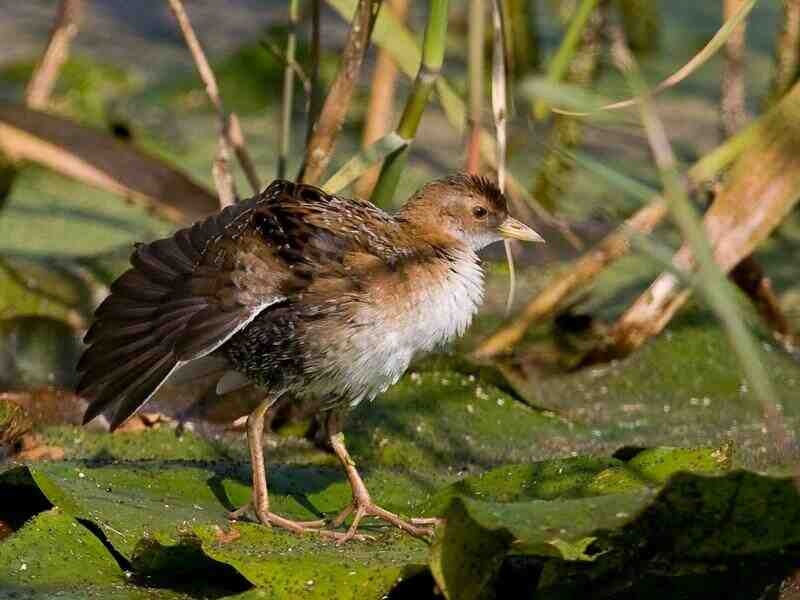Coturnicops exquisitus
IUCN
LCBasic Information
Scientific classification
- name:Coturnicops exquisitus
- Scientific Name:Coturnicops exquisitus,Swinhoes Yellow Rail
- Outline:Wading birds
- Family:Craniformes Craneidae Froglopia
Vital signs
- length:12-14cm
- Weight:No verification yet
- lifetime:About 3-5 years
Feature
It is the smallest frog in China, not a frog.
Distribution and Habitat
Distributed in the Democratic People's Republic of Korea, South Korea, China, Japan and Mongolia. In China, it is mainly distributed in Inner Mongolia, Jiangxi, Fujian, Guangdong and other provinces.
In China, it breeds in northeastern Inner Mongolia, Heilongjiang and Jilin provinces; during migration, it passes through Jilin, Liaoning, Hebei, Shandong and the Yangtze River Basin; it winters in Fujian, Guangdong and other provinces. This bird may pass through Sichuan in spring and autumn and is a migratory bird in Sichuan Province. In terms of the geographical location of its breeding area, it belongs to the Northeast type.
It inhabits rice fields, streams, swamps, grasslands, reed ponds and nearby grass and shrubs in low mountains and hills and forest margins, and sometimes appears in forest grasslands and swamps and grasslands on both sides of rivers.
Appearance
The flowered frog is a small wading bird with a body length of 13-14 cm. It is the smallest frog in China. The body color is lighter and does not have the bright feathers like the brown-backed frog. The upper body is brown or olive brown, including the upper wing coverts, inner flight feathers and tail feathers. The entire upper body has black stripes and narrow white horizontal spots. The forehead, eyebrows, sides of the head and the upper part of the back of the neck are light olive brown with small white spots. The eye lines are dark brown. The primary flight feathers are light brown and the secondary flight feathers are white, forming significant white spots on the wings, which are clearly visible when flying. The cheeks, throat and chest are dirty white, with light olive-brown horizontal spots on the chest, the belly is light yellow-white, the flanks and under the tail are olive-brown with white horizontal spots, and the underwing feathers and axillary feathers are white. The iris
Details
The foreign name of the Swinhoes Yellow Rail is Swinhoes Yellow Rail, and there is no subspecies.

Some of the Swinhoes Yellow Rail are summer migratory birds, while others are winter migratory birds. In Northeast China, they are mostly summer migratory birds, in the east, they are winter migratory birds, and in other places, they migrate to the Northeast breeding grounds in mid-April in spring and leave in mid-to-late September in autumn.
The flower quail often comes out to the open grassland in the morning and evening, and moves and forages in the grass near the river or lake. It is mostly active at dawn and dusk, and often hides in the grass during the day. When it encounters danger, it quickly runs to the grass or waterside. After reaching the waterside, it either enters the water to swim or flies to the other side of the water. Sometimes when threatened, it often lowers its head and tail to run on the ground, or hides in the grass or bushes. It mainly feeds on aquatic insects and other small invertebrates. It mainly feeds on aquatic insects, crustaceans and algae. It is very secretive.
The breeding season of the flower quail is from May to July. It nests in the grass near the water. In the breeding ecology, it goes through courtship, nesting, egg laying, hatching and raising chicks. Courtship is an important feature of sexual maturity. Male birds often fight with each other when they enter sexual maturity. Prolonging the light hours, suitable environmental temperature and nutritious feed are all important factors that promote birds to estrus. Bird nests are important places for birds to lay eggs, hatch and raise chicks. Egg laying begins after nesting. During the egg-laying period, the interval between each two eggs is not quite the same, and each nest usually lays 6 eggs. The color of the eggs is pink and yellow, with reddish brown and lavender spots. Incubation is an important stage of its reproductive life. Incubation is mostly done by female birds, and male birds guard beside the nest or in the nest area. The young birds can walk and leave the nest with their parents to forage soon after hatching, and will no longer return to the nest.
The distribution area of the flower chicken is narrow and the number is extremely rare. The reason is habitat destruction: industry, water conservancy, fishing, grazing, land reclamation, watering and reed farming, and reed cutting have destroyed its habitat. Natural enemies eat its eggs and chicks, such as birds of prey, ravens, weasels, tigers, wolves, red foxes, etc., and are hunted. Due to its rare value, criminals hunt it in large numbers for profit.
Listed in the 2012 Red List of Endangered Species of the World Conservation Union (IUCN) ver 3.1-Vulnerable (VU).
Listed in the second level of the National Key Protected Wildlife List.
Protect wildlife and eliminate game.
Maintaining ecological balance is everyone's responsibility!








